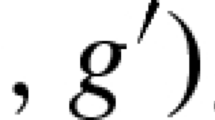Abstract
The central role played in the representation theory of reductive algebraic groups, semisimple Lie algebras and quantum groups by the Hecke algebra of the corresponding Weyl group, as the lieu where the basic combinatorial phenomena take place, has progressively become clear during the past two decades, chiefly through the works of George Lusztig. There has also been great progress in the purely combinatorial theory of Coxeter groups and Hecke algebras; we would like to cite for instance the papers of Kazhdan and Lusztig [17], Deodhar [5, 6, 7], Björner and Wachs [1], Dyer [9, 14], Brink and Howlett [3], and Brenti [2]. In particular, in [17] the celebrated Kazhdan-Lusztig polynomials were introduced, which are the “shadows” in the Hecke algebra of the perverse sheaves on the flag manifold; these polynomials will be the main theme in the present paper. They form a fascinating computational challenge, because of the difficulty of performing extended computations about them, because they and their subsequent generalizations provide the key to the understanding of the various representation theories involved, and because there are still many open questions about them, which seem hard to attack in the absence of more example material. For a review of the computational achievements in this area, the reader may consult [4].
Access this chapter
Tax calculation will be finalised at checkout
Purchases are for personal use only
Preview
Unable to display preview. Download preview PDF.
Similar content being viewed by others
Bibliography
A. Björner, M. Wachs: Bruhat order of Coxeter groups and shellability, Advances in Math. 43 (1982), pp. 87–100.
F. Brenti: A combinatorial formula for Kazhdan-Lusztig polynomials, Invent. Math. 118 (1994), pp. 371–394.
B. Brink, R. Howlett: A finiteness property and an automatic structure for Coxeter groups, Math. Ann. 296 (1993), no. 1, pp. 179–190.
F. du Cloux: The state of the art in the computation of Kazhdan-Lusztig polynomials, AAECC 7 (1996), no. 3
V.V. Deodhar: Some characterizations of Bruhat ordering on a Coxeter group and determination of the relative Möbius function, Invent. Math. 39 (1977), pp. 187–198.
V.V. Deodhar: On some geometric aspects of Bruhat ordering I: A finer decomposition of Bruhat cells, Invent. Math. 79 (1985), pp. 499–511.
V.V. Deodhar: On some geometric aspects of Bruhat ordering II: The parabolic analogue of Kazhdan-Lusztig polynomials, J. Algebra 111 (1987), pp. 483–506.
M. Dyer: On some generalizations of the Kazhdan-Lusztig polynomials for “universal” Coxeter groups, J. Algebra 116 (1988), pp. 353–371.
M. Dyer: Reflection subgroups of Coxeter systems, J. Algebra 135 (1990), pp. 57–73.
M. Dyer: On the “Bruhat graph” of a Coxeter system, Comp. Math. 78 (1991), pp. 185–191.
M. Dyer: The nil Hecke ring and Deodhar’s conjecture on Bruhat intervals, Invent. Math. 111 (1993), pp. 571–574.
M. Dyer: Bruhat intervals, polyhedral cones and Kazhdan-Lusztig polynomials, Math. Z. 215 (1994), pp. 223–236.
M. Dyer: Representation theories from Coxeter groups, in: Representations of groups (N. Allison and G. Cliff, eds.), CMS Conference Proceedings 16 (1995), pp. 105–139.
M. Dyer: On coefficients of q in Kazhdan-Lusztig polynomials,in:Algebraic groups and Lie groups (G. Lehrer, ed.), Cambridge University Press, Cambridge, 1997.
A. Garsia, T. McLarnan: Relations between Young’s natural and Kazhdan-Lusztig representations of S n , Adv. in Math. 69 (1988), no. 1, pp. 32–92.
J.E. Humphreys: Reflection groups and Coxeter groups,Cambridge University Press, Cambridge, 1990
D. Kazhdan, G. Lusztig: Representations of Coxeter groups and Hecke algebras, Invent. Math. 53 (1979), pp. 165–184.
R.P. Stanley: Enumerative Combinatorics,vol. 1, Cambridge University Press, Cambridge, 1997.
P. Polo: Construction de polynômes de Kazhdan-Lusztig, submitted to CRAS.
Editor information
Editors and Affiliations
Rights and permissions
Copyright information
© 1999 Springer Basel AG
About this paper
Cite this paper
du Cloux, F. (1999). Some Open Problems in the Theory of Kazhdan-Lusztig polynomials and Coxeter groups. In: Dräxler, P., Ringel, C.M., Michler, G.O. (eds) Computational Methods for Representations of Groups and Algebras. Progress in Mathematics, vol 173. Birkhäuser, Basel. https://doi.org/10.1007/978-3-0348-8716-8_11
Download citation
DOI: https://doi.org/10.1007/978-3-0348-8716-8_11
Publisher Name: Birkhäuser, Basel
Print ISBN: 978-3-0348-9740-2
Online ISBN: 978-3-0348-8716-8
eBook Packages: Springer Book Archive



